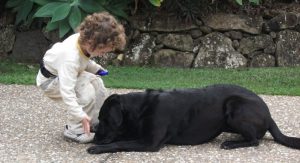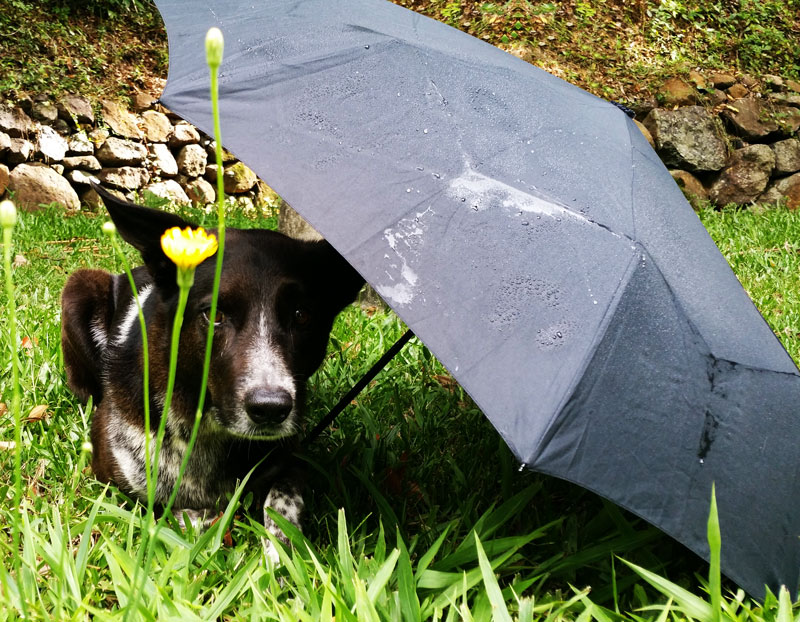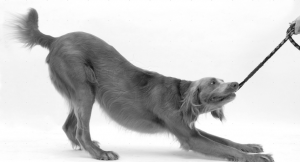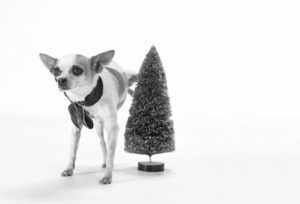DOGS AND CHILDREN
 Most problems with dogs and kids are predictable and occur as a result of bad management, poor socialisation with children and/or rough handling especially around food or sleeping areas. Children look, move, smell and act differently to adults and may unknowingly encroach on a dog’s space, move erratically, make strange noises or unintentionally hurt the dog.
Most problems with dogs and kids are predictable and occur as a result of bad management, poor socialisation with children and/or rough handling especially around food or sleeping areas. Children look, move, smell and act differently to adults and may unknowingly encroach on a dog’s space, move erratically, make strange noises or unintentionally hurt the dog.
Problems can generally be prevented if you: Desensitise your dog to grabbing hands. Start by gently taking hold of your dog’s collar or neck fur or tail and giving them a little treat. Slowly increase the strength and length of your grabs & hugs – reward consistently. We are not trying to punish the dog but to teach them that it’s ok to be grabbed & hugged – there are rewards for patience!
Reward your dog for ignoring fast motion and screams and giggles. This is where your basic training will help – don’t allow your dog to chase and jump on children. If your dog does not respond, physically separate. Sometimes an audio tape of children playing can help to desensitise a dog to the loud sounds of play.
Do not encourage or play rough wrestling games with your dog and certainly do not allow children to play these games. All games should be directed on toys, never arms or legs.
Teach your dog to swap and share food, toys & treats rather than ‘resource guard’ e.g. growl if someone approaches their food bowl while eating. Although dogs deserve peace when they eat, they must also learn to tolerate the presence of people including children as this could occur at any time in a family situation.
Don’t punish growling but DO take notice of the circumstances in which it occurs, or you may only achieve in eliminating your dog’s warning but not his fear – resulting in a more dangerous dog. The dog is saying to you or your child “I’m not happy about this situation, I don’t want to bite you, but I will if I have to”. Now, you must take time to retrain a different emotional response by re-associating the unpleasant situation with a more positive experience.
“Every child should have two things: a dog and a mother willing to let them have one.”
Under supervision make certain your dog allows you and your child to approach their sleeping area to have a gentle pat and treat. Although it is important for your dog to have a ‘safety zone’ there may be time when your child or someone else’s approaches this area and your dog should be able to cope.
S.E.E. – problems that may arise and most will be prevented.
Supervise – never leave children and dogs alone together – for the safety of both. It is not fair to expect a dog to accept the torments that small children may unintentionally apply nor to put your child at risk from a dog who may react to such treatment, or whose play may become rough and inappropriate with a child.
Educate – young children about correct behaviour around dogs and involve them in basic training exercises. Educate yourselves and your dog.
Escape – routes should always be provided for your dog. There must be somewhere where he can settle quietly and be left in peace. The majority of dogs, would rather flee than fight. Crate training is a great way to manage dogs and kids in the home environment. Remember, most dogs readily accept all members of the family unit, it just takes a little training, management and commonsense.
By kind permission of Karin Bridge.
REMEMBER PREVENT RATHER THAN CURE (OR AT LEAST TRY TO) ‘BE PROACTIVE NOT REACTIVE’




